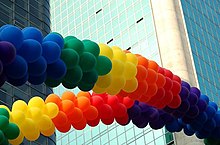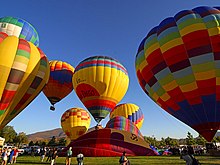Balloon: Difference between revisions
m Reverted edits by 212.219.232.92 (talk) to last version by Roadrunnerz45 |
|||
| Line 9: | Line 9: | ||
==Etymology== |
==Etymology== |
||
The word '''balloon''' was originally derived from the [[French language|French]] word ''ballon'', meaning large ball. This was in turn probably from the [[latin]] ''ballone'', but another possible source for it was ''balla'', meaning ball, from [[Old High German]].<ref>{{cite web |url= http://www.m-w.com/dictionary/balloon|title= Definition of balloon|accessdate=2007-04-29 |format= HTML|work= Merriam-Webster online dictionary|publisher= [[Merriam-Webster]]}}</ref> Other related words include the [[Middle English]] ''bal'', which was probably from the Old English ''beall'', both meaning ball. Another source may have been from the [[French language|French]] word balle, meaning "ball."<ref>{{cite web |url= http://www.m-w.com/dictionary/ball|title= Definition of ball|accessdate=2007-04-29 |format= HTML|work= Merriam-Webster online dictionary|publisher= [[Merriam-Webster]]}}</ref> |
The word '''balloon''' was originally derived from the [[French language|French]] word ''ballon'', meaning large ball. This was in turn probably from the [[latin]] ''ballone'', but another possible source for it was ''balla'', meaning ball, from [[Old High German]].<ref>{{cite web |url= http://www.m-w.com/dictionary/balloon|title= Definition of balloon|accessdate=2007-04-29 |format= HTML|work= Merriam-Webster online dictionary|publisher= [[Merriam-Webster]]}}</ref> Other related words include the [[Middle English]] ''bal'', which was probably from the Old English ''beall'', both meaning ball. Another source may have been from the [[French language|French]] word balle, meaning "ball."<ref>{{cite web |url= http://www.m-w.com/dictionary/ball|title= Definition of ball|accessdate=2007-04-29 |format= HTML|work= Merriam-Webster online dictionary|publisher= [[Merriam-Webster]]}}</ref> |
||
wuzzup hunni chiken doodle pie......... |
|||
==History== |
==History== |
||
Revision as of 13:06, 28 April 2008
- This article is about balloons in general. See also Balloon (aircraft) and Toy balloon.

A balloon is a flexible bag filled with a type of gas, such as helium, hydrogen, nitrous oxide or air. Early balloons were made of dried animal bladders. Modern balloons can be made from materials such as rubber, latex, polychloroprene or a nylon fabric. Some balloons are purely decorative, while others are used for specific purposes such as meteorology, medical treatment, military defense, or transportation. A balloon's properties, including its low density and relatively low cost, have led to a wide range of applications.
Etymology
The word balloon was originally derived from the French word ballon, meaning large ball. This was in turn probably from the latin ballone, but another possible source for it was balla, meaning ball, from Old High German.[1] Other related words include the Middle English bal, which was probably from the Old English beall, both meaning ball. Another source may have been from the French word balle, meaning "ball."[2]
wuzzup hunni chiken doodle pie.........
History
The first balloon was invented by Brazilian-born Portuguese priest, Bartolomeu de Gusmão, and the first public exhibition was to the Portuguese Court on August 8, 1709, in the hall of the Casa da India in Lisbon. The rubber balloon was invented by Michael Faraday in 1824; it was inflated with hydrogen and used in his experiments with that element.[3]. The more familiar latex balloons of today were first manufactured in London, 1847, by J.G. Ingram,[4] but mass production did not occur until the 1930s.[citation needed]
Applications
Decoration or entertainment

Party balloons are mostly made of natural latex tapped from rubber trees and can be filled with air, helium, water, or any other suitable liquid or gas. The rubber's elasticity makes the volume adjustable. Most of this rubber is made from recycled material, such as old tires and tennis shoes. [citation needed]
Filling the balloon with air is done with the mouth, with a manual or electric inflater (such as a hand pump), or with a source of compressed gas.
When rubber balloons are filled with helium so that they float, they typically retain their buoyancy for only a day or so. The enclosed helium atoms escape through small pores in the latex which are larger than the helium atoms. Balloons filled with air usually hold their size and shape much longer.
Even a perfect rubber balloon eventually loses the gas to the outside. The process by which a substance or solute migrates from a region of high concentration, through a barrier or membrane, to a region of lower concentration is called diffusion. The inside of balloons can be treated with a special gel (for instance, the polymer solution sold under the "Hi Float" brand) which coats the inside of the balloon to reduce the helium leakage, thus increasing float time to a week or longer.

Beginning in the late 1970s, some more expensive (and longer-lasting) foil balloons have been made of thin, unstretchable, less permeable metalized plastic films. These balloons have attractive shiny reflective surfaces and are often printed with color pictures and patterns for gifts and parties. The most important attribute of metalized nylon for balloons is its light weight, increasing buoyancy and its ability to keep the helium gas from escaping for several weeks. However, there has been some environmental concern, since the metalized nylon does not biodegrade or shred as a rubber balloon does, and a helium balloon released into the atmosphere can travel a long way before finally bursting or deflating. Release of these types of balloons into the atmosphere is considered harmful to the environment. This type of balloon can also conduct electricity on its surface and released foil balloons can become entangled in power lines and cause power outages.
Released balloons can land almost anywhere, including on nature preserves or other areas where they pose a serious hazard to animals through ingestion or entanglement. Latex balloons are especially dangerous to sea creatures because latex retains its elasticity for 12 months or more when exposed to sea water rather than air.[5] Because of the harm to wildlife and the effect of litter on the environment, some jurisdictions even legislate to control mass balloon releases. Legislation proposed in Maryland, USA was named after Inky, a pygmy sperm whale who needed 6 operations after swallowing debris, the largest piece of which was a mylar balloon.[6][7]
Professional balloon party decorators use electronic equipment to enable the exact amount of helium to fill the balloon. For non-floating balloons air inflators are used. Professional quality balloons are used, which differ from most retail packet balloons by being larger in size and made from 100% biodegradable latex.
Balloon modeling and balloons in art
Balloon artists are entertainers who twist and tie inflated tubular balloons into sculptures (see balloon animal). The balloons used for balloon sculpture are made of extra-stretchy rubber so that they can be twisted and tied without bursting. Since the pressure required to inflate a balloon is inversely proportional to the diameter of the balloon, these tiny tubular balloons are extremely hard to inflate initially. A pump is usually used to inflate these balloons.
Decorators may use hundreds of helium balloons to create balloon sculptures. Usually the round shape of the balloon restricts these to simple arches or walls, but on occasion more ambitious "sculptures" have been attempted. It is also common to use balloons as tables decorations for celebratory events. Table decorations normally appear with 3 or 5 balloons on each bouquet. Ribbon is curled and added with a weight to keep the balloons from floating away.Model of the Balloons
Water balloons
Water balloons are thin, small rubber balloons intended to be easily broken. They are usually used by children, who throw them at each other, trying to get each other wet, as a game or practical joke. They can be used in competitions or games. They are smaller than regular balloons.
Balloon rockets
Balloons are often deliberately released, creating so called balloon rocket or rocket balloon. Rocket balloons work because the elastic balloons contract on the air within them, and so when the mouth of the balloon is left open, the gas within the balloon shoots out, and, due to Newton's third law of motion, the balloon is propelled forward. This is fundamentally the same way that a rocket works.[8]
Flying machines

Large balloons filled with hot air or buoyant gas have been used as flying machines since the 18th century. The earliest flights were made with hot air balloons using air heated with a flame, or hydrogen; later, helium was used.
-
Caption1
Medicine
Angioplasty is a surgical procedure in which very small balloons are inserted into blocked or partially blocked blood vessels near the heart. Once in place, the balloon is inflated to clear or compress arterial plaque, and to stretch the walls of the vessel, thus preventing myocardial infarction. A small stent can be inserted at the angioplasty site to keep the vessel open after the balloon's removal.[9]
Balloon catheters are catheters that have balloons at their tip to keep them from slipping out. For example, the balloon of a Foley catheter is inflated when the catheter is inserted into the urinary bladder and secures its position.[10]
See also
- Aerobot
- Atlas (rocket)
- Balloon-carried light effect
- Balloon mail
- Balloon animal
- Balloon modelling
- Balloon rocket
- Captive balloon
- Cluster ballooning
- Gas balloon
- Helium
- Hot air balloon
- Hopper balloon
- Inflatable
- List of balloon uses
- Radiosonde
- Rockoon
- Speech balloon
- Weather balloon
Notes
- ^ "Definition of balloon" (HTML). Merriam-Webster online dictionary. Merriam-Webster. Retrieved 2007-04-29.
- ^ "Definition of ball" (HTML). Merriam-Webster online dictionary. Merriam-Webster. Retrieved 2007-04-29.
- ^ Robertson, Patrick. The Book of Firsts, Bramhall House, NY, 1978.
- ^ "Balloon History" (HTML). BalloonsIT. Retrieved 2007-04-29.
- ^ Andrady, A.L. (2006-08-06). "Plastics and Their Impacts in the Marine Environment". Proceedings of the International Marine Debris Conference on Derelict Fishing Gear and the Ocean Environment. Hawaii: Hawaiian Islands Humpback Whale National Marine Sanctuary. p. 140. Retrieved 2006-12-02.
{{cite conference}}: Check date values in:|date=(help); Unknown parameter|booktitle=ignored (|book-title=suggested) (help) - ^ "MARP Sponsors Inky Legislation". Aquarium in Baltimore. Retrieved 2006-12-01.
- ^ "Legislation regulating the release of balloons". Clean Virginia Waterways. Retrieved 2006-12-01.
- ^ Zimmerman Jones, Andrew. "Scientific Explanation: Why the Rocket Balloon Works" (HTML). How to Create a Rocket Balloon. About:Physics. Retrieved 2007-04-29.
- ^ Berger, Alan (2006-05-30). "Angioplasty" (HTML). Medical Encyclopedia. MedlinePlus. Retrieved 2007-04-28.
{{cite web}}: Check date values in:|date=(help); Cite has empty unknown parameter:|coauthors=(help) - ^ Bellis, Mary. "History of the Catheter - Balloon Catheter - Thomas Fogarty" (HTML). About: Inventors. About. Retrieved 2007-04-28.
External links
- Stratospheric balloons, history and present Historical recopilation project on the use of stratospheric balloons in the scientific research, the military field and the aerospace activity
- National trade association for the UK balloon industry
- National trade association for the Australasian balloon industry
- Royal Engineers Museum Royal Engineers and Aeronautics
- Royal Engineers Museum Early British Military Ballooning (1863)

